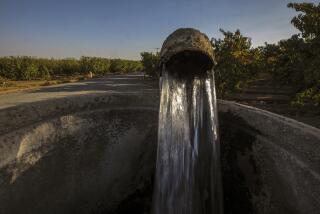Agriculture’s Big Thirst Is No Longer a Sacred Cow : Irrigation still uses 80% of all water distributed in the state
- Share via
Something long overdue is coming to California’s water policy--some candor about where the richest and most populous state will get the water it needs in years to come.
From one wet year to another, regional politics have almost always dominated debate on water issues. In such years, Northern California, where most of the state’s supply is captured for distribution to cities and farms, can stifle calls for action from Southern California, where the need for water outstrips supply. In such years, farmers can drown out complaints that they waste enough water irrigating marginal lands to more than make up for shortages in cities. Not this year.
Quite suddenly, agriculture is on the defensive, and serious meetings are being called to discuss future policies that involve people who have scarcely talked to one another since the last drought of the 1970s: urban water managers, environmental activists, farmers, northerners and southerners.
What turned the tables--so that questions about future water resources will dominate regional politics at least for a while--is the fifth year of a drought of historic proportions. As Times writer Kevin Roderick reported recently in chronicling the drought, water levels in California’s most important reservoirs fell during December, a month when they almost invariably collect more water.
That hit home a week ago in Southern California.
The Metropolitan Water District already had served notice that it would cut residential water deliveries to the 27 local agencies that depend on the MWD for all or most of their supplies by 5% and agricultural deliveries by 10%. After reservoir levels fell, the district squeezed its local agencies even tighter, cutting residential supplies by 10% and agricultural deliveries by 30%. That same day Sen. David A. Roberti (D-Los Angeles), Senate president pro tem, hoisted water policy from near the bottom to the very top of his list of issues for 1991.
Not only that, the first of three steps he recommended in his outline to ensure adequate water supplies for all of California would require mandatory reductions in water used for irrigation, which accounts for 80% of all water distributed in the state. Next, he said, the state should concentrate on cleaning up polluted aquifers and building new storage facilities to hold water that falls during the winter for delivery during the summer.
The California Water Code gives urban use preference over agricultural use, but the language is vague, and it is worse than vague--silent, in fact--on the crucial question of the circumstances that would give urban users the first crack at water supplies. In years past, when the federal government could always find the dollars for a new dam or reservoir or canal, urban leaders seldom mentioned the water code. Cities often needed farmers on their side in lobbying for new water projects, and discussing urban preference irritated irrigators.
In recent years, analysts have been more vocal in challenging agriculture’s claim to so much of the state’s water. Nor have politicians, notably Assemblyman Phillip Isenberg (D-Sacramento), been shy about talking about it.
Isenberg, who probably knows water policy better than any other elected official in Sacramento, said flatly early this year that in his opinion future supplies of water for growing urban areas would come “from a reallocation of water conserved by agriculture.”
To illustrate the potential for conservation in agriculture, Isenberg said that pasture, alfalfa, cotton and rice account for only 12% of the state’s total farm output. But the water that is used to irrigate those crops could provide urban areas with supplies adequate for something over twice the state’s present population.
Changing water policy requires more than sensible talk or reasonable outlines. Laws that deal realistically with water and California’s future are far from passage.
But with the drought, serious people are giving serious thought to the shape of new laws. That is worth celebrating.
THE WATER DRAIN
Agriculture’s share of California’s water declined from 85% in 1980 to 80% in 1985. But agricultural consumption probably will not drop below 75% in the next 20 years unless priorities are changed.
In 1,000s of acre-feet
1980:
AGRICULTURAL USE: 36,120
URBAN USE: 5,860
1985:
AGRICULTURAL USE: 32,910
URBAN USE: 6,590
2010:
AGRICULTURAL USE: 33,490
URBAN USE: 8,710
Source: California Resources Board
More to Read
Sign up for Essential California
The most important California stories and recommendations in your inbox every morning.
You may occasionally receive promotional content from the Los Angeles Times.













